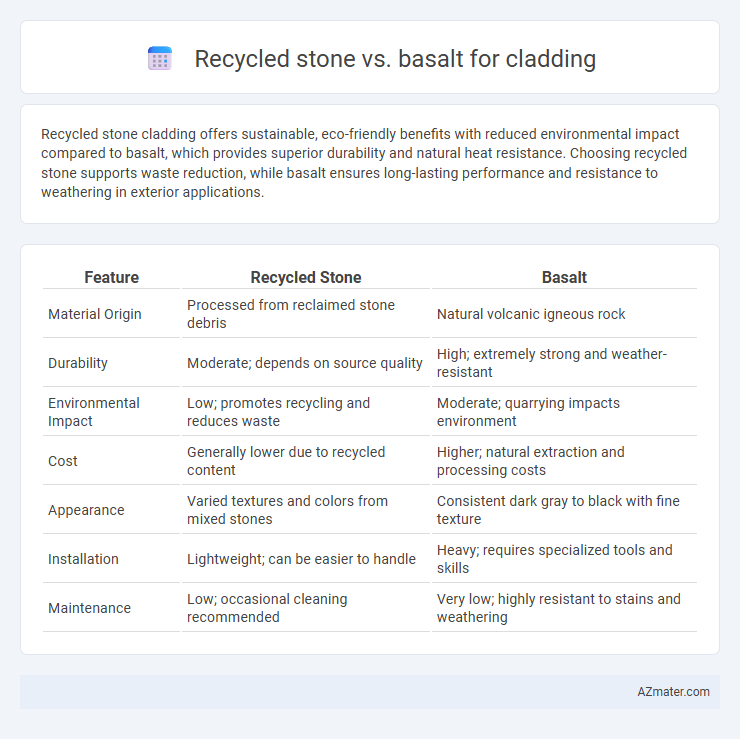Recycled stone cladding offers sustainable, eco-friendly benefits with reduced environmental impact compared to basalt, which provides superior durability and natural heat resistance. Choosing recycled stone supports waste reduction, while basalt ensures long-lasting performance and resistance to weathering in exterior applications.
Table of Comparison
| Feature | Recycled Stone | Basalt |
|---|---|---|
| Material Origin | Processed from reclaimed stone debris | Natural volcanic igneous rock |
| Durability | Moderate; depends on source quality | High; extremely strong and weather-resistant |
| Environmental Impact | Low; promotes recycling and reduces waste | Moderate; quarrying impacts environment |
| Cost | Generally lower due to recycled content | Higher; natural extraction and processing costs |
| Appearance | Varied textures and colors from mixed stones | Consistent dark gray to black with fine texture |
| Installation | Lightweight; can be easier to handle | Heavy; requires specialized tools and skills |
| Maintenance | Low; occasional cleaning recommended | Very low; highly resistant to stains and weathering |
Introduction to Cladding Materials
Recycled stone and basalt are popular cladding materials known for durability and aesthetic appeal in architectural applications. Recycled stone offers an eco-friendly alternative, reducing waste while maintaining natural stone's texture and strength. Basalt, a volcanic igneous rock, provides superior hardness and weather resistance, making it ideal for long-lasting exterior cladding solutions.
What is Recycled Stone Cladding?
Recycled stone cladding consists of repurposed natural stone materials from demolished structures, offering an eco-friendly alternative to new stone. It retains the durability and aesthetic appeal of original stone while minimizing environmental impact through waste reduction and resource conservation. This sustainable option provides a unique texture and character, making it suitable for both modern and traditional architectural applications.
Understanding Basalt Cladding
Basalt cladding offers superior durability, natural resistance to weathering, and an attractive dark, fine-grained appearance ideal for modern architectural facades. Compared to recycled stone, basalt provides enhanced thermal insulation and greater strength, making it a preferred choice for long-lasting exterior applications. Its volcanic origin ensures consistent mineral composition, contributing to its stability and minimal maintenance requirements in cladding projects.
Aesthetic Differences: Recycled Stone vs Basalt
Recycled stone offers a unique, textured appearance with varied color tones and irregular patterns, enhancing a rustic or eco-friendly aesthetic for cladding projects. Basalt features a consistent dark gray to black hue with a fine-grained, smooth surface that provides a sleek, modern look. The choice between recycled stone and basalt depends on desired visual impact, where recycled stone emphasizes natural variation and character, while basalt delivers uniformity and contemporary elegance.
Durability and Longevity Comparison
Recycled stone offers sustainable cladding options but typically exhibits lower durability and lifespan compared to basalt, which is renowned for its exceptional hardness and resistance to weathering. Basalt's dense crystalline structure ensures superior longevity, often exceeding 50 years with minimal maintenance, making it ideal for exterior applications exposed to harsh environmental conditions. While recycled stone may be cost-effective and eco-friendly, basalt remains the preferred choice for long-term durability and structural integrity in cladding projects.
Environmental Impact and Sustainability
Recycled stone cladding significantly reduces environmental impact by repurposing existing materials, minimizing quarrying and lowering waste in landfills. Basalt, a natural volcanic rock, offers durability and thermal mass benefits but requires energy-intensive extraction and transportation processes. Prioritizing recycled stone enhances sustainability by lowering carbon emissions and conserving natural resources compared to basalt.
Installation Process and Complexity
Recycled stone cladding offers a more straightforward installation process due to its lighter weight and uniform panel sizes, reducing labor time and the need for heavy equipment. Basalt cladding, while highly durable and aesthetically striking, demands specialized cutting tools and skilled labor to handle its dense, hard composition, increasing both complexity and installation time. Selecting between recycled stone and basalt depends on balancing project timelines with desired durability and natural stone appeal.
Cost Analysis: Recycled Stone vs Basalt
Recycled stone offers a cost-effective alternative to basalt for cladding, typically reducing material expenses by 30-50% due to lower extraction and processing costs. Basalt, valued for its durability and natural aesthetic, commands higher prices often ranging from $15 to $30 per square foot, while recycled stone commonly falls between $8 and $15 per square foot. Labor and installation costs remain comparable, but the overall project budget favors recycled stone when optimizing for affordability without compromising structural integrity.
Maintenance Requirements
Recycled stone cladding typically demands less maintenance due to its engineered durability and resistance to weathering, while basalt, a natural volcanic rock, requires regular sealing to prevent staining and moss growth. The porous nature of basalt can lead to higher susceptibility to dirt accumulation and erosion, necessitating more frequent cleaning and protective treatments. Recycled stone's consistency in composition often translates to longer-lasting aesthetic appeal with minimal upkeep compared to basalt's variable surface texture.
Choosing the Right Cladding for Your Project
When choosing cladding for your project, consider recycled stone for its eco-friendly properties and unique, weathered appearance that adds character to facades. Basalt offers exceptional durability, high compressive strength, and low maintenance, making it ideal for long-lasting exterior cladding. Evaluate project priorities such as sustainability goals, aesthetic preferences, and budget constraints to select the optimal material for performance and design impact.

Infographic: Recycled stone vs Basalt for Cladding
 azmater.com
azmater.com